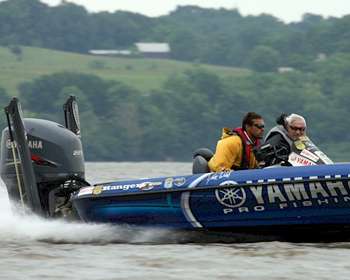
Topwaters are synonymous with fall bass fishing. But as leaves begin to change color and eventually fall to the ground and as air temperatures begin to dip, the effectiveness of topwater baits is put into question.
Just how cold is too cold for a topwater bite?
"When the water drops below 50 degrees, it's time to put up the topwaters," says Elite Series pro Dave Wolak. "I've done a lot of fall and spring bass fishing over the years and 52 degrees is the magic number below which the bass become bottom oriented as opposed to chasing anything."
Wolak is quick to point out that, especially in early winter after an unusually warm fall, air temperature can trick an angler into prematurely stowing the topwaters. Just because it's cold outside doesn't mean the topwater bite isn't hot. "I like to target the topwater bite if the water temperature has been in the low 60s and then a massive cold front blasts the area and the air temperature drops into the 30s," he explains.
Wolak urges anglers to think of snow and sleet storms during the early winter months the same way as rain and thunderstorms during the warmer months of the year. The bass don't know if it's snowing, sleeting or raining, and it really doesn't matter to them. It's all about the change in barometric pressure.
During his rookie season in 2005, Wolak made the cut on Lake Norman by keying on the surface bite during a sleet storm. "During the storm, the only way that I could get a bite was working a jerkbait as fast as I could across the surface and waking a spinnerbait," he remembers. "I never imagined it would be effective in weather that cold, but the fish were reacting to the barometric pressure drop. There was a bluebird sky the following day and that bite disappeared."
Topwater baits are also effective in colder water because during the late fall bass spend the majority of their time gorging themselves on shad that are located in the upper half of the water column.
"This time of year, the bass are shad-oriented and they're going to blast something on the surface if the temperature is right and there is a barometric pressure drop," Wolak claims. His go-to topwater offering in early winter is usually a buzzbait because it mimics a flickering shad and triggers a reaction strike as it moves past the bass.
Even though you may find yourself on the water this winter during perfect topwater conditions, there's no guarantee for success.
"This is going to sound weird," explains Wolak, "but some lakes are just better than others for this type of late season topwater bite." He says that he has fished lakes that are located right next to each other and had success on one while the other didn't produce.
"It's just worth at try," concludes Wolak. "If you have the right conditions (a dramatic air temperature drop after a warming trend), try topwater because the bass are reacting to the barometric pressure. They're not thinking about the snow."




